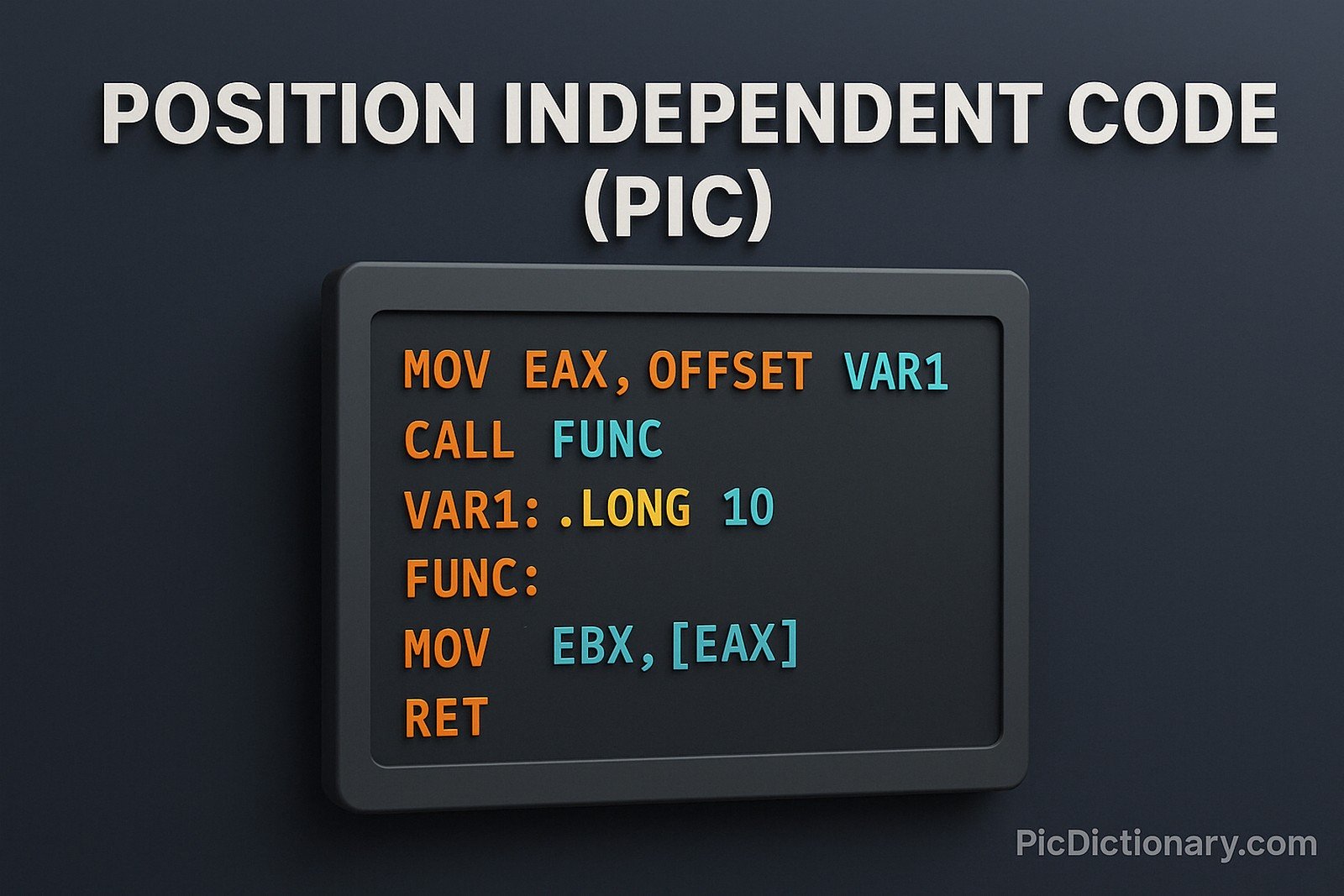Position Independent Code (PIC)

Quick Navigation:
- Position Independent Code (PIC) Definition
- Position Independent Code (PIC) Explained Easy
- Position Independent Code (PIC) Origin
- Position Independent Code (PIC) Etymology
- Position Independent Code (PIC) Usage Trends
- Position Independent Code (PIC) Usage
- Position Independent Code (PIC) Examples in Context
- Position Independent Code (PIC) FAQ
- Position Independent Code (PIC) Related Words
Position Independent Code (PIC) Definition
Position Independent Code (PIC) is a type of machine code that executes correctly regardless of its absolute memory address. Instead of using absolute addresses, PIC uses relative addressing, enabling the same code to run at different memory locations without modification. This is especially crucial in shared libraries and dynamic linking, where the operating system loads code at varying addresses to optimize memory usage and prevent conflicts.
Position Independent Code (PIC) Explained Easy
Imagine writing a letter that someone could read no matter where they open it — in a kitchen, garden, or spaceship. The letter has directions like "look left" or "go two steps forward" instead of specific addresses. Position Independent Code (PIC) works the same way. The computer doesn't rely on fixed addresses but uses instructions like "go relative to where you are." That way, it can run from any place in memory.
Position Independent Code (PIC) Origin
PIC originated from the need for more flexible and efficient memory management in operating systems. As dynamic linking became prevalent, operating systems needed code that could run from any location in memory without modification. This led to the adoption of PIC in Unix-based systems and eventually in Windows and embedded platforms.
Position Independent Code (PIC) Etymology
The term has roots in computing, describing code that is not fixed to a single "position" in memory but can adapt to different locations using relative addressing.
Position Independent Code (PIC) Usage Trends
PIC has seen significant growth, particularly with the rise of dynamic linking, containerized applications, and security measures like ASLR. It is widely used in modern operating systems, shared libraries, and executable binaries to reduce vulnerability to attacks and improve system efficiency. Developers in the embedded space and cloud computing environments also rely on PIC for portable, secure, and efficient code execution.
Position Independent Code (PIC) Usage
- Formal/Technical Tagging:
- Dynamic Linking
- Shared Libraries
- Memory Management
- Address Space Layout Randomization (ASLR) - Typical Collocations:
- "position independent executable"
- "shared object compiled with PIC"
- "PIC binary"
- "addressing in PIC format"
Position Independent Code (PIC) Examples in Context
- A shared library in Linux is typically compiled with Position Independent Code (PIC) to allow dynamic loading.
- Modern operating systems use PIC to help randomize code locations and reduce attack surfaces.
- In embedded systems, PIC allows firmware to run from different memory addresses without changes.
Position Independent Code (PIC) FAQ
- What is Position Independent Code (PIC)?
PIC is machine code that can run correctly regardless of its memory location, using relative addressing. - Why is Position Independent Code (PIC) important?
It allows dynamic linking and improves security by supporting address randomization. - Is PIC used in Windows and Linux?
Yes, both platforms use PIC in shared libraries and system binaries. - Does using PIC affect performance?
There may be a slight performance overhead, but it improves flexibility and security. - Can PIC help with system security?
Yes, it supports ASLR, making systems less predictable and more secure. - Where is PIC commonly used?
In shared libraries, dynamically linked executables, and embedded systems. - Is PIC required for all executables?
Not necessarily, but it's essential for shared libraries and position-independent executables (PIE). - Can PIC be used in embedded systems?
Yes, especially in scenarios where code needs to run from different locations. - How do you compile code with PIC?
Using compiler flags like `-fPIC` in GCC for generating position-independent code. - What is the relationship between PIC and PIE?
PIE (Position Independent Executable) is an executable that is compiled with PIC principles, enabling relocation at runtime.

Position Independent Code (PIC) Related Words
- Categories/Topics:
- Dynamic Linking
- Memory Management
- Computer Security
- Shared Libraries
Did you know?
Position Independent Code (PIC) is one of the key enablers behind the security feature known as ASLR, which makes it harder for hackers to predict the location of code in memory. Without PIC, ASLR wouldn't be possible, leaving systems more vulnerable to exploits.
PicDictionary.com is an online dictionary in pictures. If you have questions or suggestions, please reach out to us on WhatsApp or Twitter.Authors | Arjun Vishnu | @ArjunAndVishnu

I am Vishnu. I like AI, Linux, Single Board Computers, and Cloud Computing. I create the web & video content, and I also write for popular websites.
My younger brother, Arjun handles image & video editing. Together, we run a YouTube Channel that's focused on reviewing gadgets and explaining technology.



Comments powered by CComment